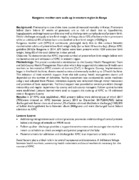| dc.description.abstract | Background: Prematurity is one of the main causes of neonatal mortality in Kenya. Premature babies (born before 37 weeks of gestation) are at risk of death due to hypothermia, hypoglycaemia and respiratory conditions as well as the long-term complications of preterm birth. Similar challenges are apply to low birth weight. In Kenya about 12% of babies are born premature while an additional 8% of babies born are classified as low birth weight (<2500gm)
Kangaroo mother care (KMC) is continuous, prolonged, early skin to skin contact between mother/other adult and preterm/low birth weight baby (for at least 18 hours a day). (Kenya KMC guideline 2016)In Bungoma in 2014 ,673 babies were born preterm while 1324 were low birth weight, being 6% of the total deliveries in that period.
Objective: To demonstrate that KMC improves survival of preterm/low birth weight babies with increased access and utilization of KMC in western region
Methodology: The project conducted a sensitization to the County Health Management Team and Sub County Health Management Team after which they supported the selection 8 health care workers to be trained as KMC trainers of trainers (ToT) in Bungoma County. Implementation began in five health facilities, thenincreased to nine and eventually scaled up to 27health facilities. The selection of sites waswith support from the sub county health management teams and depended on the number of deliveries. Facility assessment was conducted to assess readiness using a tool adopted from Malawi; institution capacity was enhanced through minor renovation and provision of basic equipment. Technical support was provided to service providers through mentorship and regular supervision by county and sub county managers. Follow up mechanisms were established .Lessons learned were used to support the scale up of KMC to 18 additional sites in Bungoma County
Results: In 27 KMC sites established , 4025 preterm babies were delivered out of which 2817 (70%)were initiated on KMC between January 2015 to December 2017,2640(96%) babies discharged with better chances of survival ,3%of babies admitted died before discharge,(1108)30% of babies dischargedwere born between above 2000grams and were discharged home before admission to KMC
Lessons Learnt
• Addressing retrogressive social cultural practices, promotes understanding of care of preterm babies and change of attitude on MNH issues
• Follow up after discharge provides a supportive environment and encourages the mother to return as schedule to check on weight and general progress of the baby
• Maternal criteria for admission and discharge for KMC is as important as baby criteria
Social factors play a critical role in its overall acceptance and sustenance. A deliberate linkage between health workers, community health volunteers and social workers is necessary for the success of KMC | en_US |

